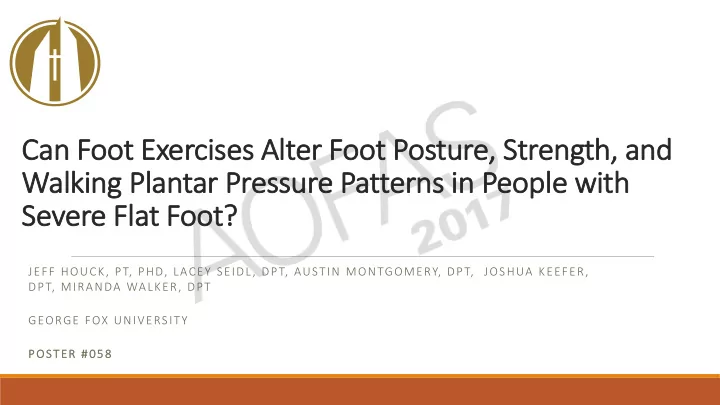

Can Can Foot t Exer ercises ises Alt lter er Foot t Postur ture, e, Str treng ength, th, and and Walking Pl Wa Plantar r Pr Pressure Patterns in People with Se Sever ere F e Flat F Foot? JEFF HOUCK, PT, PHD, LACEY SEIDL, DPT, AUSTIN MONTGOMERY, DPT, JOSHUA KEEFER, DPT, MIRANDA WALKER, DPT GEORGE FOX UNIVERSITY PO POSTER #0 #058
No Conflicts to Disclosure The authors have no potential conflicts of interest to disclose. Jeff Houck, PT, PhD, Lacey SeidL, DPT, Austin Montgomery, DPT, Joshua Keefer, DPT, Miranda Walker, DPT The authors disclosures are listed in the FINAL AOFAS mobile APP
Background Muscle training for barefoot running (i.e. doming seated and standing) and post foot and ankle injury (i.e. seated plantar flexion and inversion) are common. (McKeon PO, et al. Br J Sports Med 2015) Although studies demonstrated improvement in foot posture (validated foot posture index [FPI]) immediately following a 4-week exercise program this was not assessed in people with flatfoot. More rigorous assessment of foot function in response to exerecise is lacking (i.e. foot posture, strength, and plantar pressure during walking) and may assist individuals with flat foot. If specific exercises have a strong influence on foot function in patients with non-painful flat foot these exercises may be beneficial for patients with various pain syndromes (e.g. plantar fasciitis) and after truama (i.e. Foot and ankle fractures).
Purpose The purpose of this pilot study was to assess the immediate effect of a 4-week exercise program on a comprehensive assessment of foot function to evaluate the potential for a more rigorous clinical trial. Study Design- Case Series (Pre/Post Exercise Test)
Methods - Sample ○ Eighteen individuals ○ 8 with a severe flatfoot , measured by foot posture index (FPI) (> 6/12, average=8.4±0.7 [max score possible = 10]), age=27.8±6.9, 7 females and 1 male) Pre/Post Exercise Testing ○ 9 age/gender matched controls with a normal foot (FPI=0-5, ○ average=2.2±2.0) participated. Tested once (did NOT perform exercise) ○
Methods - Exercise The Exercise group completed 3 foot exercises Seated plantar flexion and Doming (standing) inversion Doming (seated) Frequency was - 5 days/week twice daily.
Methods – Pre/Post Exercise Measures Gait Analysis ○ Plantar pressure during a controlled walking cadence (110 bpm) (average of 5 steps over 40 feet). ○ Masks were applied (medial/lateral toes and forefoot, heal, midfoot) and specific variables calculated (peak pressure, percent mean pressure) during stance phase. Paper Pull Test Clinical tests ○ heel rise repetitions – standardized published methods ○ navicular drop - calipers ○ paper pull test (peak force) - Evaluated with 3D embedded force plate ○ Analysis ○ T-tests were used to assess the effects of pre to post in the SFF group and between the SFF group and ○ AMC pre and post exercise.
Results - Gait Analysis – Plantar Pressure Flat Foot Participant Control Post-Exercise Pre-Exercise Lateral forefoot mask - percent total mean pressure was lower in the Flat Foot group pre exercise versus controls (right p=0.02, left p=0.07). Lateral fore foot mask - pre to post exercise peak plantar pressure increased (left p=0.014, right p=0.02) and percent of total mean pressure also increased (right p=0.04, left p = 0.07).
Results - Clinical Tests Heel Rise Endurance – significantly increased from pre to post exercise in the flat foot participants ○ Pre-Exercise Post-Exercise Right 25.6 31.8 Left 25.8 33.6 Navicular Drop ○ Indicated less arch lowering on the right (p=0.4) and left (p=0.06) ○ Paper Pull Test (peak force) ○ No pre/post test differences ○ Graph 3: * indicates p-value < .05
Conclusions ● The findings of this study support the hypothesis that a 4-week foot muscle training program can affect foot posture, foot pressure data and foot muscle strength in people with asymptomatic flat feet. ● The increases in heel rise endurance and plantar pressure data are significant and suggest an important clinical benefit may arise from strengthening of the foot in patients with flat foot. ● However, this preliminary findings requires study in a larger data set.
References 1. Boland, D. M., Feldtmann, D. P. T. J. J., Mcpoil, D. P. T. T., Christie, D. S., Molloy, J. M., & Goffar, S. L. (2011). Static Foot Posture Associated With Dynamic Plantar Pressure Parameters, 41 (2), 100–107. doi:10.2519/jospt.2011.3412 2. Diliberto, F. E., Tome, J., Baumhauer, J. F., Quinn, J. R., Houck, J., & Nawoczenski, D. A. (2015). Multi-joint foot kinetics during walking in people with Diabetes Mellitus and peripheral neuropathy. Journal of Biomechanics , 48 (13), 3679–3684. doi:10.1016/j.jbiomech.2015.08.020 3. Neville, C., Flemister, A. S., & Houck, J. (2013). Total and Distributed Plantar Loading in Subjects With Stage II Tibialis Posterior Tendon Dysfunction During Terminal Stance. doi:10.1177/1071100712460181 4. Okita, N., Meyers, S. a., Challis, J. H., & Sharkey, N. a. (2014). Midtarsal joint locking: New perspectives on an old paradigm. Journal of Orthopaedic Research , 32 (1), 110–115. doi:10.1002/jor.22477 5. Wager, J. C., & Challis, J. H. (2016). Elastic energy within the human plantar aponeurosis contributes to arch shortening during the push-off phase of running. Journal of Biomechanics , 49 (5), 704–709. doi:10.1016/j.jbiomech.2016.02.023
Recommend
More recommend